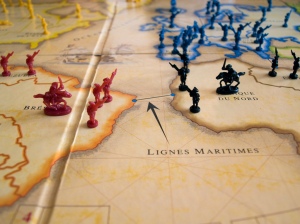 Is it okay to do something that technically breaks the law, but causes no harm to others? Where is the line between what society forbids or restricts and what the individual wants to do anyway? What about doing something legal, and while it isn’t causing harm to others right now, still carries that risk?
Is it okay to do something that technically breaks the law, but causes no harm to others? Where is the line between what society forbids or restricts and what the individual wants to do anyway? What about doing something legal, and while it isn’t causing harm to others right now, still carries that risk?
Felix Salmon wrote an interesting, ethics-based counter to Randy Cohen’s opinion piece on bicyclists who run red lights. I’ll let you read each and draw your own conclusions about whether one or the other is on solid ethical grounds (you may or may not find it ironic that Cohen was formerly the Ethicist writer for the New York Times and has a book coming out called, “Be Good: How to Navigate the Ethics of Everything.”)
That’s stupid and I’m smart
To me, there was another aspect that is relevant to all of us as well, both as individuals as well as organizations. It relates to people’s chronic underestimation of risk and overestimation of their ability. Cohen touches on it, but I think he falls into a common trap about risk in doing so (seemingly to rationalize his own behavior – a common cognitive error.)
It’s this: “It’s okay what I/we do as long as I/we cause no harm to others.” It’s the philosophical “free-pass” to rationalize breaking rules without having to feel guilty about it. In fact, you can even feel more ethically-intelligent about it!
But there’s more to it. The companion quote is: “And I/we cause no harm to others because I/we are more careful/better than others.” This is a cognitive bias of the first order.
We’ve seen it in environmental disasters and the way the most recent financial crisis has unfolded. We see it in the way some businesses and individuals in those businesses continue to behave even after the consequences of their previous actions have been recognized, exposed, and reported on. In many cases, the rationale is either, “I/we broke no law” or “Even if we did violate a regulation, our actions caused no direct harm to others.”
It’s okay, I’m being very careful
The problem is that laws to stop at red lights aren’t there because we think that people intentionally drive into intersections if they knew they would crash into someone. It’s because even as careful as you think you are, misteaks happen.
It’s to a certain extent about risk. Risk is the bad thing that might happen. It doesn’t mean it will happen. A person could go their entire (natural) life running red lights “when it was safe” and never have an accident. A company could cut corners on pipeline inspections for decades and never have an oil spill. Another could get extremely leveraged on risky loans and never have to ask for a bailout (hey, it could happen!) The list goes on. Things where nothing bad happens even though a law or regulation is broken (or not.)
Checklists serve a similar purpose in reducing risk. Surgeons don’t intend to leave instruments in patients. Pilots don’t purposely ignore instrument readings. It’s easy to think that checklists are an unnecessary burden for you (but maybe not the other guy.) But as all humans are susceptible to errors in thinking and perception, even the most careful of us can think we took out all the retractors, checked all the dials, and examined all lanes heading into the intersection.
There is a whole spectrum here. For instance, we’ve seen that in the financial industry, companies take great effort to find loopholes in existing regulations, invent new financial products that aren’t regulated yet, or redefine existing products so that regulations don’t apply. When it comes down to it, is that really any different than ignoring a law? Is it okay since “everyone else is doing it?”
This wasn’t supposed to happen
Even when you point out the dire consequences *if* something was to go wrong, it’s very easy for people to come up with a back of the envelope calculation about why the % probability of something bad happening times the consequence is far, far lower than what “that other careless guy” or “that other greedy/reckless company” is doing.
So it’s okay. It’s not causing harm to others. Until it does.
Photo by CarbonNYC











 Strategy is founded on risk and risk is inherently subjective to the views of the people involved, including employees and management. As a result, HR has a great opportunity to improve the way in which risk impacts strategic success for the business, going beyond the more tactical or operational perspective HR has previously taken.
Strategy is founded on risk and risk is inherently subjective to the views of the people involved, including employees and management. As a result, HR has a great opportunity to improve the way in which risk impacts strategic success for the business, going beyond the more tactical or operational perspective HR has previously taken.